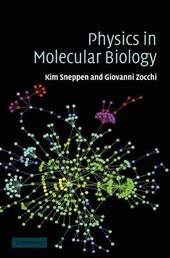
|
Physics in Molecular Biology
Hardback
Main Details
| Title |
Physics in Molecular Biology
|
| Authors and Contributors |
By (author) Kim Sneppen
|
|
By (author) Giovanni Zocchi
|
| Physical Properties |
| Format:Hardback | | Pages:320 | | Dimensions(mm): Height 251,Width 173 |
|
| Category/Genre | Genetics (non-medical) |
|---|
| ISBN/Barcode |
9780521844192
|
| Classifications | Dewey:572.8015118 |
|---|
| Audience | | Professional & Vocational | | Tertiary Education (US: College) | |
|---|
| Illustrations |
100 Halftones, unspecified; 80 Line drawings, unspecified
|
|
Publishing Details |
| Publisher |
Cambridge University Press
|
| Imprint |
Cambridge University Press
|
| Publication Date |
25 August 2005 |
| Publication Country |
United Kingdom
|
Description
Tools developed by statistical physicists are of increasing importance in the analysis of complex biological systems. Physics in Molecular Biology discusses how physics can be used in modeling life. It begins by summarizing important biological concepts, emphasizing how they differ from the systems normally studied in physics. A variety of topics, ranging from the properties of single molecules to the dynamics of macro-evolution, are studied in terms of simple mathematical models. The main focus of the book is on genes and proteins and how they build systems that compute and respond. The discussion develops from simple to complex systems, and from small-scale to large-scale phenomena. This book will inspire advanced undergraduates and graduate students in physics to approach biological subjects from a physicist's point of view. It is self-contained, requiring no background knowledge of biology, and only familiarity with basic concepts from physics, such as forces, energy, and entropy.
Author Biography
Kim Sneppen is Professor of Biophysics at the Nordic Institute for Theoretical Physics (NORDITA) and Associate Professor at the Niels Bohr Institute, Copenhagen. Giovanni Zocchi is Assistant Professor of Physics at the University of California, Los Angeles.
ReviewsBecause physics is the fundamental science involved with all forms of matter, science students and academics should welcome this book by two researchers familiar with both physics and biology. Each chapter comes with references and suggestions for further reading. There is a very useful appendix on statistical physics. A glossary of biological terms and an index also come in handy. Excellent diagrams elucidate the analysis. Choice
|